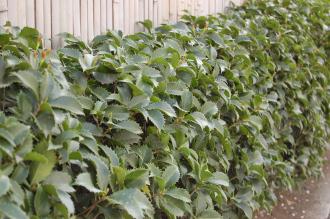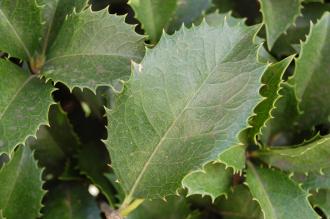
Osmanthus x fortunei (01/04/2015, Tokyo, Japan)
Position: Full sun to partial shade
Flowering period: Late summer to autumn
Soil: Moist, well drained
Eventual Height: 5m
Eventual Spread: 4m
Hardiness: 7a, 7b, 8a, 8b, 9a, 9b, 10a
Family: Oleaceae
Osmanthus x fortunei is an evergreen shrub with a rounded habit. Its mid green leaves are ovate with Holly like large spines, are up to 8cm long and 5cm broad. It fragrant white flowers are small, tubular and usually obscured by its foliage. Its blue/black fruit are ovoid and up to 12mm across.

Osmanthus x fortunei Leaf (01/04/2015, Tokyo, Japan)
Osmanthus x fortunei, commonly known as Fortunes Osmanthus or Fortunes Tea Olive, is a hybrid between Fortunei heterophyllus and Fortunei fragrans.
The etymological root of the binomial name Osmanthus is derived from the Greek osme ‘perfume’ and anthus ‘flower’. Fortunei is named after Robert Fortune (1812 – 1880) the plant explorer.
The landscape architect may find Osmanthus x fortunei useful to as specimens shrub with attractive leaves and fragrant flowers. It may also be successfully trained as an evergreen hedge which will form an effective barrier. It prefers a sheltered position.
Ecologically, Osmanthus x fortunei flowers are attractive to pollinating insects.

Osmanthus x fortunei Hedge (01/04/2015, Tokyo, Japan)
Osmanthus x fortunei prefers moist, fertile well-drained soils. It will tolerate most pH of soil, although it prefers neutral to acidic soils.
Osmanthus x fortunei requires little maintenance. Dead branches may be removed in spring or summer. Hedging plants should be clipped as necessary , usually twice a year, during the growing period.

